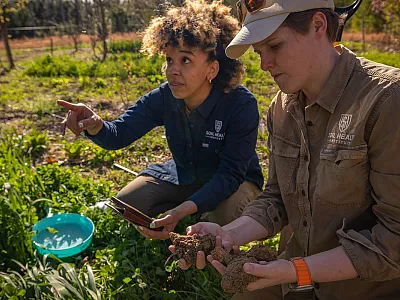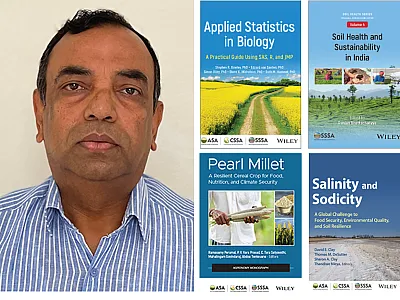Regulating Plant Growth in Cotton
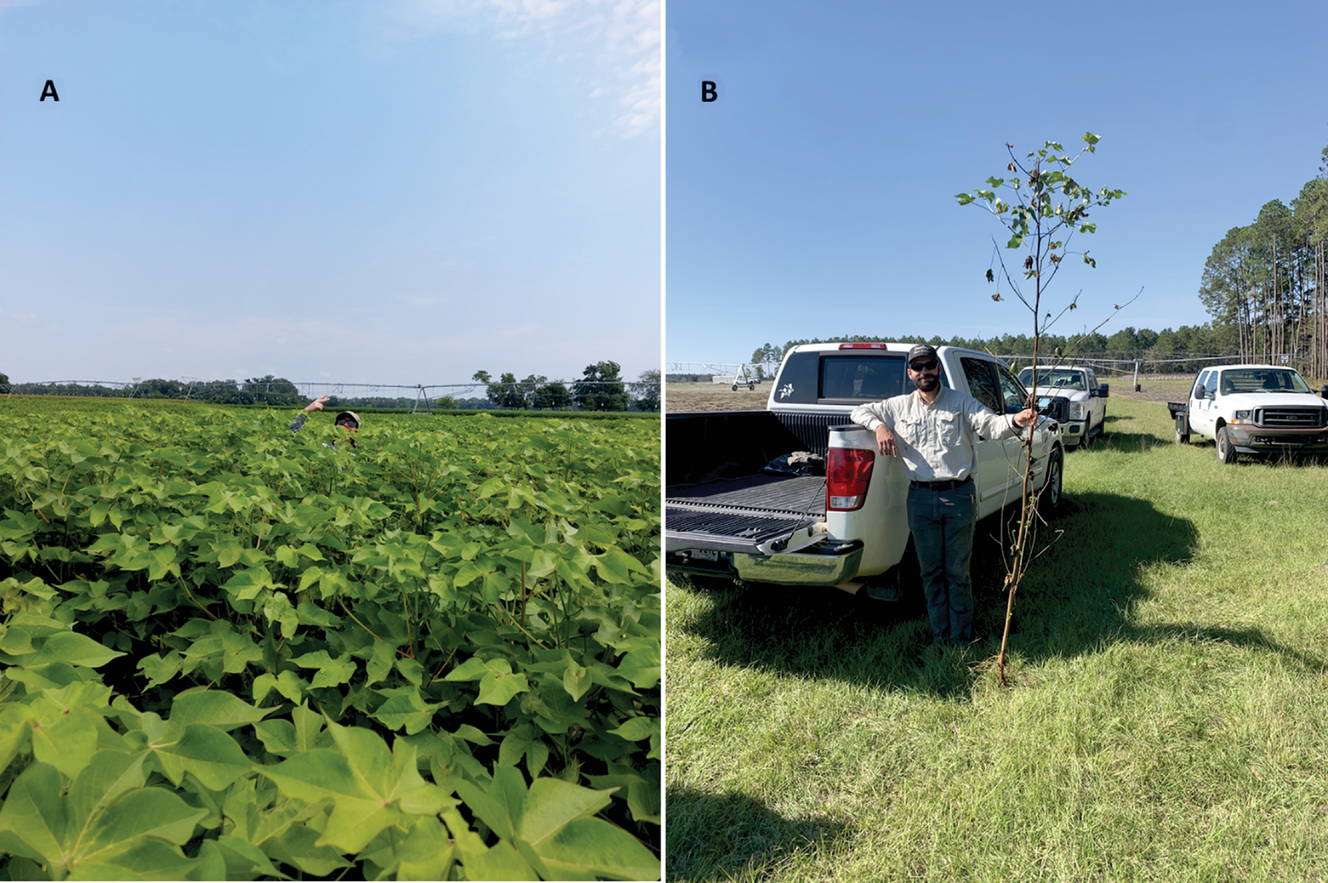

Tall cotton plants do not necessarily produce maximum yields or quality. Growth-promoting field conditions in the absence of chemical growth control can produce cotton plants that are extremely tall but exhibit excessive vegetative growth at the expense of reproductive growth. Cotton producers must often consider incorporating plant growth regulators (PGRs) as a part of their management decisions during the growing season. The focus of article is on the use of the PGR mepiquat chloride and the role of production environment, cultivar, and other management considerations. Earn 0.5 CEUs in Crop Management by reading this article and taking the quiz.
The phrase walking in high cotton has been associated with a successful crop and profitable return for the grower. The phrase has been used in conversation and even music for years, but does high cotton equal a higher return on investment? The short answer is that tall cotton plants do not necessarily produce maximum yields or quality. The cotton plant is an indeterminate perennial in its native environment. Therefore, growth‐promoting field conditions in the absence of chemical growth control can produce cotton plants that are extremely tall but exhibit excessive vegetative growth at the expense of reproductive growth (Figure 1). Cotton producers must often consider incorporating plant growth regulators (PGRs) as a part of their management decisions during the growing season. The most commonly used PGR in cotton is a 4.2% solution of mepiquat chloride (MC) commonly referred to by the original tradename Pix.
Role of Mepiquat Chloride in Cotton Production
Mepiquat chloride (MC) has been around since the 1970s, and active research on its use continues as new cotton cultivars are released, technology is advanced, and grower inputs change (Brown & Sandlin, 2019). Mepiquat chloride is a gibberellic acid (GA) synthesis inhibitor that limits cell expansion and elongation. Active plant growth is needed for MC to work because it is under these situations where cell expansion and elongation are occurring. If MC were applied to older, more mature plant tissue, the effect of MC would be minimal (Hake et al., 1991). While MC can’t shrink a cotton plant, it can produce a more compact cotton plant by the end of the season by reducing internode length, the number of mainstem nodes, and individual leaf area.
Other than noticeable changes in plant height, MC application also results in cotton leaves appearing a darker green color than leaves in untreated plants (Figure 2). The dark green canopy seen in MC‐treated plants is a consequence of having less leaf area and a higher concentration of chlorophyll per unit leaf area (Guthrie et al., 1995).
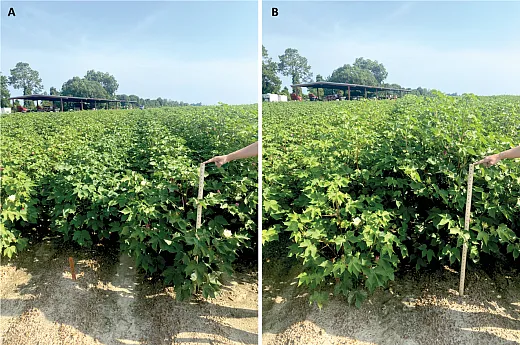
What are some of the benefits of applying MC to cotton? Mepiquat chloride can improve boll retention, shorten the number of days until physiological maturity, increase harvest efficiency, reduce lodging, and improve light penetration and air flow through the canopy. Numerous studies have been conducted to evaluate yield responses to MC application. Yield responses to MC applications have varied from negative responses to positive responses or no response to MC application (Cook & Kennedy, 2000). The objectives of a good MC management strategy are to encourage early fruit retention and prevent excess vegetative growth (Hand et al., 2022a).
So how does a cotton producer decide on an MC application strategy? This question is answered on a case‐by‐case basis since there are numerous factors affecting plant response to MC. Many factors influence the effectiveness and results obtained from MC application, but these factors can be grouped into two overarching categories: production environment and cultivar.
Production Environment
Cotton is mainly grown in areas with long growing seasons and high temperatures during the summer months. Most cotton‐producing areas in the U.S. are rainfed, and only 40% of production is under irrigated conditions. As a result, exposure to some level of water deficit stress during the season is common (Chastain et al., 2014). Cotton is particularly susceptible to drought stress occurring during flowering and boll development, which coincides with peak water use (Hand et al., 2022b). Mepiquat chloride requires actively growing plant tissue to be effective, and water is required to fuel vegetative and reproductive growth. Therefore, applications during drought are unnecessary for controlling growth, and some producers fear that MC application in combination with drought stress could cause stunted growth from which the plant may be unable to recover.
Research conducted in southern Georgia by Chalise et al. (2022) evaluated the response of three different cotton cultivars (DP 1646 B2XF, DG 3799 B3XF, and DG 3615 B3XF) grown under three different irrigation regimes (dryland, well‐watered, and over‐irrigated) to three MC management strategies (untreated, moderate, and aggressive) in the 2020 and 2021 growing seasons. Results from both years of the study showed that aggressive MC management reduced final plant height, decreased the number of mainstem nodes, and hastened maturity. Mepiquat chloride application did not affect lint yield in either year. However, it is important to note that responses to MC application were highly dependent on the year evaluated.
The 2020 growing season was a dry year characterized by yield‐limiting drought stress in the dryland treatment. The 2021 growing season was wetter, and yields were highest under dryland conditions. During the dry growing season, the MC‐induced reductions in plant height observed under dryland conditions were much less than those observed under irrigated conditions. Additionally, crop earliness was unaffected by MC management under dryland conditions, but cutout (the cessation of new vegetative growth) occurred between two and three weeks earlier under irrigated or over‐irrigated conditions. During a wet growing season, aggressive MC application hastened crop development and produced more compact plants across all irrigation treatments. These results further illustrate that MC application can only generate the desired plant responses (reduced growth, earlier maturity) if the plant isn’t under growth‐ and yield‐limiting drought stress. This study also illustrates that even dryland acres can be responsive to MC application during years with high rainfall.
Mepiquat chloride requires actively growing plant tissue to be effective, and water is required to fuel vegetative and reproductive growth. Therefore, applications during drought are unnecessary for controlling growth. Photo by Sam Craft/Texas A&M AgriLife Marketing and Communications.
Crop water use is also closely tied to crop growth, so a follow‐up experiment was conducted by Lee et al. (2023) in southern Georgia to determine if aggressive pre‐drought MC management could decrease cotton sensitivity to drought during peak water demands. The authors found that MC application prevented drought‐induced yield loss but penalized yield under water‐replete, high‐yield scenarios. Additionally, aggressive MC application followed immediately by drought stress did not penalize yield more than drought alone.
Nitrogen (N) is required in the highest quantities of any other macronutrient for cotton production. Nitrogen availability affects the yield of cotton by affecting growth dynamics and the underlying physiological processes canopy growth and carbon assimilation. Nitrogen deficiency decreases plant growth rate, leaf area per plant, photosynthetic rate, and the number of fruiting sites in addition to causing premature cutout (Bondada et al., 1996; Massignam et al., 2012; Vos & Biemond, 1992). At the other extreme, excessively high N application rates cause excess vegetative growth, lower light penetration in the canopy, poor fruit retention at lower nodes, and a delay in crop maturity (Boquet & Breitenbeck, 2000; Snider et al., 2021).
Although it is intuitive that more aggressive PGR management might be needed under high‐N conditions, interactions between N rate and PGR application strategy are seldom observed (Balkcom et al., 2022; Foote et al., 2016). This is likely because other environmental factors such as water availability interact with nutrient application rates to drive growth responses. Additionally, growth history of a given field can have a strong influence on the need for MC applications. For example, fields with a history of rank growth must be monitored and managed more closely than other fields to prevent excessive vegetative growth.
Cotton Cultivar
Along with production environment, variety plays an important role in MC management decisions. Cotton cultivars differ in their growth habits, varying from tall and aggressively growing to short with limited vegetative growth (Gwathmey & Craig, 2003). As a consequence of differences in growth and vigor, different management strategies for growth regulation are required. Additionally, cotton cultivars demonstrate differences in maturity (early maturing vs. late maturing). Generally, early maturing cultivars require less aggressive MC application because they tend to retain fruit on lower‐fruiting branch nodes, which naturally constrains new vegetative growth. However, all of these generalizations are heavily dependent on prevailing environmental conditions. As mentioned previously, growth history of a given field and the availability of water and nutrients will strongly affect the MC application strategy deployed.
Mepiquat Chloride Management Considerations
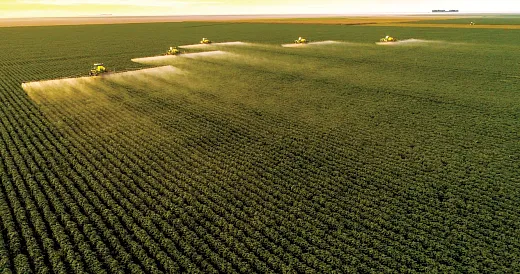
Numerous factors influence how a grower implements an MC management strategy. There is no single strategy that will work for every situation, and MC management decisions should be made on a case‐by‐case basis. Mepiquat chloride application uses and recommendations can be found through Cooperative Extension programs in each cotton‐producing state. Application strategies may need to be re‐evaluated from season to season, depending on cultivars, production inputs, environmental conditions, and field growth history. With many factors governing crop response to MC application, what is a key take‐home message a grower can glean from all this information? Monitor the crop (base decisions on growth), and apply MC according to the rates and timings needed for a specific situation.
For monitoring purposes, a number of different measurements can be taken to determine the need for an MC application. One such measurement is the height‐to‐node ratio. Normal values for cotton at key growth stages are provided in Table 1. Values in excess of this range may require an MC application. Another approach to monitor growth is the measurement of internode length. Specifically, the distance between the fourth and fifth node below the terminal is often used as an indicator of the need for an MC application since this is the most recently developed, fully expanded internode. Internode lengths ranging from 2 to 3 inches are commonly used as a threshold for making an MC application in cotton (Raper, 2015). Crop developmental stage should also be considered when deciding on the most appropriate application rate. For example, lower rates of MC are needed if applications are made in the squaring stage (floral bud development) rather than during flowering and boll development when plants are larger.
Additional information about MC management published by University of Georgia Extension can be found at https://bit.ly/43rIcSU or by scanning the QR code.
References
Balkcom, K.S., Monks, D.C., & Brown, S.M. (2022). Mepiquat chloride applications across two nitrogen rates in a conservation tillage cotton system. Journal of Cotton Science, 26. https://doi.org/10.56454/LTOH4319 Bondada, B., Oosterhuis, D., Norman, R., & Baker, W. (1996). Canopy photosynthesis, growth, yield, and boll 15N accumulation under nitrogen stress in cotton. Crop Science, 36, 127–133. Boquet, D.J., & Breitenbeck, G.A. (2000). Nitrogen rate on partitioning of nitrogen and dry matter by cotton. Crop Science, 40, 1685–1693. Brown, S., & Sandlin, T. (2019). How to think about cotton: plant growth regulators. 2019 Alabama A&M and Auburn University Extension Crop Production Blog. https://www.aces.edu/blog/topics/crop‐production/how‐to‐think‐about‐cotton‐plant‐growth‐regulators Chalise, D.P., Snider, J.L., Hand, L.C., Roberts, P., Vellidis, G., Ermanis, A., Collins, G. D., Lacerda, L. N., Cohen, Y., Pokhrel, A., Parkash, V., & Lee, J.M. (2022). Cultivar, irrigation management, and mepiquat chloride strategy: effects on cotton growth, maturity, yield, and fiber quality. Field Crops Research, 286, 108633. https://doi.org/10.1016/j.fcr.2022.108633 Chastain, D.R., Snider, J.L., Collins, G.D., Perry, C.D., Whitaker, J., & Byrd, S.A. (2014). Water deficit in field‐grown Gossypium hirsutum primarily limits net photosynthesis by decreasing stomatal conductance, increasing photorespiration, and increasing the ratio of dark respiration to gross photosynthesis. Journal of Plant Physiology, 171, 1576–1585. Cook, D.R., & Kennedy, C.W. (2000). Early flower bud loss and mepiquat chloride effects on cotton yield distribution. Crop Science, 40, 1678–1684. https://doi.org/10.2135/cropsci2000.4061678x Foote, W., Edmisten, K., Wells, R., Collins, G., Roberson, G., Jordan, D., & Fisher, L. (2016). Influence of nitrogen and mepiquat chloride on cotton canopy reflectance measurements. Journal of Cotton Science, 20, 1–7. Guthrie, D., Landivar, J., Munier, D., Stichler, C., & Weir, B. (1995). Pix application strategies. Cotton Physiology Today, 6(4) Gwathmey, C.O., & Craig Jr., C.C. (2003). Managing earliness in cotton with mepiquat‐type growth regulators. Crop Management 2(1), https://doi.org/10.1094/CM‐2003‐1222‐01‐RS Hake, K., Kerby, T., McCarty, W., O’Neal, D., & Supak, J. (1991). Physiology of pix. Cotton Physiology Today, 2(6) Hand, C., Culpepper, S., Harris, G., Kemerait, R., Liu, Y., Perry, C., & Bag, S. (2022b). UGA cotton production guide. http://www.ugacotton.com/production‐guide Hand, C., Snider, J., & Roberts, P. (2022a). Cotton growth monitoring and PGR management (Publication No. 1244). University of Georgia Cooperative Extension. Lee, J.M., Snider, J.L., Roberts, P., Hand, L.C., Culpepper, A.S., Pokhrel, A., & Chalise, D.P. (2023). The effect of pre‐drought mepiquat chloride management on cotton sensitivity to drought during peak water demands. Field Crops Research, 298, 108969. Massignam, A.M., Chapman, S.C., Hammer, G.L., & Fukai, S. (2012). Effects of nitrogen supply on canopy development of maize and sunflower. Crop Pasture Science, 62, 1045–1055. Raper, T. (2015). Plant growth management of new cotton varieties. UTcrops News Blog. University of Tennessee, Institute of Agriculture. Snider, J., Harris, G., Roberts, P., Meeks, C., Chastain, D., Bange, M., & Virk, G. (2021). Cotton physiological and agronomic response to nitrogen rate. Field Crops Research, 270, 108194. Vos, J., & Biemond, H. (1992). Effects of nitrogen on the development and growth of the potato plant. 1. Leaf appearance, expansion growth, life spans of leaves and stem branching. Annals of Botany, 70, 27–35.
Self-Study CEU Quiz
Earn 0.5 CEUs in Crop Management by taking the quiz. For your convenience, the quiz is printed below. The CEU can be purchased individually, or you can access as part of your Online Classroom Subscription.
Mepiquat chloride reduces internode length in cotton by inhibiting the synthesis of
a. abscisic acid.
b. ethylene.
c. gibberellic acid.
d. cytokinins.
- Based on Chalise et al. (2022) for Georgia cotton, what is the most likely response of cutout date and yield to MC application under growth‐ and yield‐limiting drought stress?
- Earlier cutout date and higher yield when compared with untreated plants
- Later cutout date and higher yield when compared with untreated plants
- Later cutout date and lower yield when compared with untreated plants
- No difference in cutout date or yield when compared with untreated plants
- One of the reasons excessive vegetative growth is not favored in cotton is because it
- delays crop maturity.
- promotes earliness.
- ensures air flow in the crop canopy.
- results in less lodging.
- Cotton producers can use one widely accepted MC management strategy for all cotton production situations.
- True.
- False.
- To avoid making unnecessary MC applications to the cotton crop, which MC management strategy will be most effective?
- A single application of 16 oz/ac Pix at the first flower stage of development.
- Three applications of growth‐stage‐specific rates of Pix at squaring, first flower, and peak bloom.
- A single application of 24 oz/ac Pix at peak bloom.
- Monitor growth. Only make applications when growth thresholds are met. Apply MC at recommended rates for specific growth stages.
Text © . The authors. CC BY-NC-ND 4.0. Except where otherwise noted, images are subject to copyright. Any reuse without express permission from the copyright owner is prohibited.




